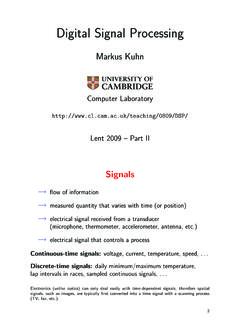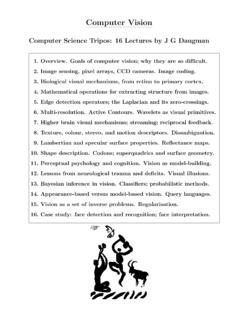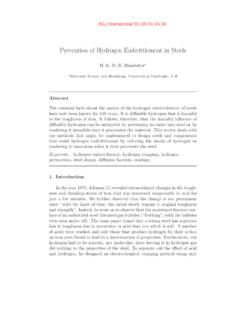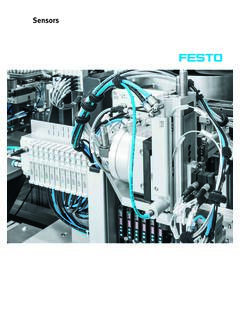Transcription of An introduction to inertial navigation
1 Technical ReportNumber 696 Computer LaboratoryUCAM-CL-TR-696 ISSN 1476-2986An introduction to inertial navigationOliver J. WoodmanAugust 200715 JJ Thomson AvenueCambridge CB3 0 FDUnited Kingdomphone +44 1223 763500 2007 Oliver J. WoodmanTechnical reports published by the University of CambridgeComputer Laboratory are freely available via the Internet: 1476-2986An introduction to inertial navigationOliver J. WoodmanAbstractUntil recently the weight and size of inertial sensors has prohibited their use in domains such ashuman motion capture. Recent improvements in the performance of small and lightweight micro-machined electromechanical systems (MEMS) inertial sensors havemade the application of inertialtechniques to such problems possible. This has resulted in an increased interest in the topic ofinertial navigation , however current introductions to the subject fail to sufficiently describe the errorcharacteristics of inertial introduce inertial navigation , focusing on strapdown systems based on MEMS devices.
2 A com-bination of measurement and simulation is used to explore the error characteristics of such a simple inertial navigation system (INS) based on the Xsens Mtx inertial measurement unit(IMU), we show that the average error in position grows to over 150 m after60 seconds of propagation of orientation errors caused by noise perturbing gyroscope signals is identified as thecritical cause of such drift. By simulation we examine the significance of individual noise processesperturbing the gyroscope signals, identifying white noise as the process which contributes most tothe overall drift of the fusion and domain specific constraints can be used to reduce drift in INSs. For an exampleINS we show that sensor fusion using magnetometers can reduce the average error in position obtainedby the system after 60 seconds from over 150 m to around 5 m.
3 We conclude that whilst MEMSIMU technology is rapidly improving, it is not yet possible to build aMEMS based INS which givessub-meter position accuracy for more than one minute of IntroductionThis report provides an introduction to inertial navigation and the error characteristics of inertial navi-gation systems. Its purpose is to address the lack of a readable introduction into the subject which doesnot oversimplify or ignore the error properties of inertial navigation systems. The report also aims toexplain the meaning and significance of performance specification measurements such as noise density and bias stability which are often stated by reader should note that whilst this report aims to provide a broad introduction to the subjectof inertial navigation , the latter chapters focus mainly on strapdown typeinertial navigation systemsusing micro-machined electromechanical systems (MEMS) devices.
4 MEMS technology is of particularinterest at the current time since it offers rugged, low cost, small and lightweight inertial sensors relativeto the other available technologies. The performance of MEMS inertial devices isalso improving the report a simple inertial navigation system (INS) is developed based on an Xsens Mtxdevice. The report is structured as follows: Section 2 introduces the reader to inertial navigation , its uses, and the two main varieties of inertialnavigation system. Sections 3 and 4 describe gyroscopes and accelerometers in detail. Both sections contain an overviewof the different types of sensors available, as well a description of error sources. Section 5 introduces Allan Variance, a technique which can be used to detect and measure thenoisecharacteristics of gyroscope and accelerometer Section 6 describes strapdown inertial navigation in more detail and explains how errors in indi-vidual gyroscopes and accelerometers propagate through the navigation system as a whole.
5 Theperformance of a simple INS is analysed in order to illustrate the relative importance of noiseperturbing the gyroscope and accelerometer signals. Section 7 describes how simulation can be used to analyse the relative importance of different noisesources. A simple simulator is constructed and verified against the real system developed in Section6. Section 8 introduces several methods for reducing drift in inertial 1: The body and global frames of inertial NavigationInertial navigation is a self-contained navigation technique in which measurements provided by accelerom-eters and gyroscopes are used to track the position and orientation of anobject relative to a known startingpoint, orientation and velocity. inertial measurement units (IMUs) typically contain three orthogonalrate-gyroscopes and three orthogonal accelerometers, measuring angular velocity and linear accelerationrespectively.
6 By processing signals from these devices it is possible to trackthe position and orientationof a device, as described in Section navigation is used in a wide range of applications including the navigation of aircraft, tacticaland strategic missiles, spacecraft, submarines and ships. Recent advances in the construction of MEMS devices have made it possible to manufacture small and light inertial navigation systems. These advanceshave widened the range of possible applications to include areas such as human and animal inertial System ConfigurationsNearly all IMUs fall into one of the two categories outlined below. The difference between the twocatagories is the frame of reference in which the rate-gyroscopes and accelerometers operate. Throughoutthis report we will refer to the navigation system s frame of reference as the body frame and to the frameof reference in which we are navigating as the global frame, as shown in Figure Stable Platform SystemsIn stable platform type systems the inertial sensors are mounted on a platform which is isolated fromany external rotational motion.
7 In other words the platform is held in alignment with the global is achieved by mounting the platform using gimbals (frames) which allow the platform freedom inall three axes, as shown in Figure 2. The platform mounted gyroscopes detect any platform signals are fed back to torque motors which rotate the gimbals in order to cancel out such rotations,hence keeping the platform aligned with the global track the orientation of the device the angles between adjacent gimbals can beread using anglepick-offs. To calculate the position of the device the signals from the platform mounted accelerometersare double integrated. Note that it is necessary to subtract acceleration due to gravity from the verticalchannel before performing the integration. The stable platform inertial navigation algorithm is shown inFigure 2: A stable platform 3: Stable platform inertial navigation 4: Strapdown inertial navigation Strapdown SystemsIn strapdown systems the inertial sensors are mounted rigidly onto the device, and therefore outputquantities measured in the body frame rather than the global frame.
8 To keep track of orientation thesignals from the rate gyroscopes are integrated , as described in Section 6. To track position the threeaccelerometer signals are resolved into global coordinates using the known orientation, as determined bythe integration of the gyro signals. The global acceleration signals arethen integrated as in the stableplatform algorithm. This procedure is shown in Figure platform and strapdown systems are both based on the same underlying principles. Strapdownsystems have reduced mechanical complexity and tend to be physically smaller than stable platformsystems. These benefits are achieved at the cost of increased computational complexity. As the cost ofcomputation has decreased strapdown systems have become the dominant type of 5: A conventional mechanical gyroscope (source: [1]).3 Types of GyroscopeIn this section the main types of gyroscope are presented.
9 Note that this is far from an exhaustive particular there are many different varieties of mechanical gyroscope whichare not described. A morecomprehensive survey can be found in [1]. MechanicalA conventional gyroscope consists of a spinning wheel mounted on two gimbals which allow it to rotatein all three axes, as show in Figure 5. An effect of the conservation of angular momentum is that thespinning wheel will resist changes in orientation. Hence when a mechanical gyroscope is subjected to arotation the wheel will remain at a constant global orientation and the angles between adjacent gimbalswill change. To measure the orientation of the device the angles between adjacent gimbals can be readusing angle pick-offs. Note that a conventional gyroscope measures orientation. In contrast nearly allmodern gyroscopes (including the optical and MEMS types outlined in Sections and ) arerate-gyros, which measure angular main disadvantage of mechanical gyroscopes is that they contain moving parts.
10 Moving partscause friction, which in turn causes the output to drift over time. To minimise friction high-precisionbearings and special lubricants are used, adding to the cost of the device. Mechanical gyroscopes alsorequire a few minutes to warm up, which is not ideal in many OpticalA fibre optic gyroscope (FOG) uses the interference of light to measure angular velocity. A FOG consistsof a large coil of optical fibre. To measure rotation two light beams are fired into the coil in oppositedirections. If the sensor is undergoing a rotation then the beam travelling in the direction of rotationwill experience a longer path to the other end of the fibre than the beam travelling against the rotation,as illustrated in Figure 6. This is known as the Sagnac effect. When the beams exitthe fibre they arecombined. The phase shift introduced due to the Sagnac effect causes the beams to interfere, resultingin a combined beam whose intensity depends on the angular velocity.
















